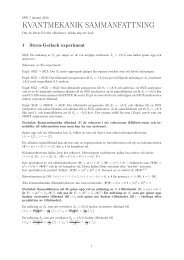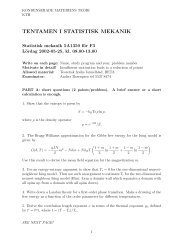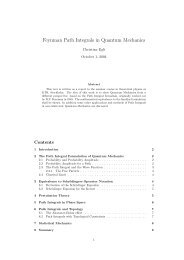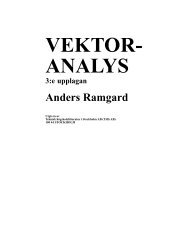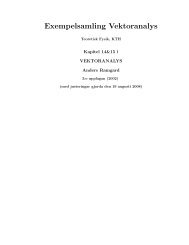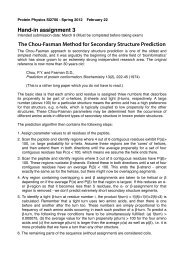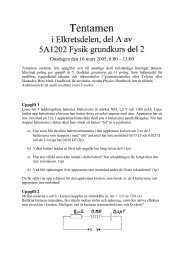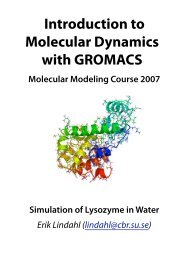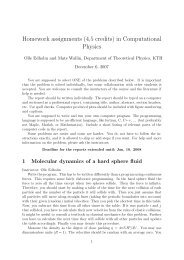[VAR]=Notes on variational calculus
[VAR]=Notes on variational calculus
[VAR]=Notes on variational calculus
You also want an ePaper? Increase the reach of your titles
YUMPU automatically turns print PDFs into web optimized ePapers that Google loves.
Problem 2: Find the shortest/extremal path <strong>on</strong> a given surface embedded in three<br />
dimensi<strong>on</strong>s which c<strong>on</strong>nects two given points A and B <strong>on</strong> this surface.<br />
To formulate this problem in a mathematical language I assume the surface is given<br />
by a C 2 functi<strong>on</strong> z = z(x, y) in Cartesian coordinates, and that x i , y i , z i = z(x i , y i ) for<br />
i = 0 and i = 1 are the Cartesian coordinates of the two points A and B, respectively.<br />
Then the path c<strong>on</strong>necting A and B can be parametrized by a vector valued functi<strong>on</strong><br />
x(t) = (x(t), y(t)), 0 ≤ t ≤ 1, and such that x(0) = x 0 = (x 0 , y 0 ) and x(1) = x 1 =<br />
(x 1 , y 1 ). The length of such a path is<br />
L =<br />
∫ B<br />
A<br />
ds =<br />
∫ B<br />
A<br />
√<br />
dx2 + dy 2 + dz 2 ,<br />
and using dx = x ′ (t)dt, dy = y ′ (t)dt, and dz = [z x (x(t), y(t))x ′ (t)+z y (x(t), y(t))x ′ (t)]dt<br />
we get<br />
∫ 1 √<br />
L[x] = x ′ (t) 2 + y ′ (t) 2 + [z x (x(t), y(t))x ′ (t) + z y (x(t), y(t))x ′ (t)] 2 dt. (2)<br />
0<br />
L[x] again is a functi<strong>on</strong>al (now <strong>on</strong> a different space of functi<strong>on</strong>s), and mathematically<br />
we again have a variati<strong>on</strong>al problem, but now of a functi<strong>on</strong> with values in R 2 :<br />
Problem 2’: Find the C 2 functi<strong>on</strong> x <strong>on</strong> the interval [0, 1] with values in (a subset<br />
of) R 2 (i.e. x is given by x(t) = (x(t), y(t)) with t in [0, 1]), fixed at the end points:<br />
x(0) = x 0 and x(1) = x 1 , and which minimizes the functi<strong>on</strong>al in (2).<br />
The following is an example of a variati<strong>on</strong>al problem for a functi<strong>on</strong> in two variables:<br />
Problem 3: A homogeneous membrane is fixed in a given frame (which is not even).<br />
Find the shape of the membrane.<br />
A possible shape of the membrane can be described by a functi<strong>on</strong> u(x) where x =<br />
(x, y) is a point in a two dimensi<strong>on</strong>al domain Ω, 3 where the boundary ∂Ω parametrizes<br />
the frame where u(x) is fixed: u(x) <strong>on</strong> ∂Ω equals some given functi<strong>on</strong>s α(x). [To have a<br />
specific example: assume that the membrane is a circular disc of radius R. The u(x) is<br />
a functi<strong>on</strong> defined for r < R such that u(r)| r=R = α(θ) where (x, y) = r(cos(θ), sin(θ))<br />
are polar coordinates.]<br />
The physical principle determining the shape of the membrane is: “the potential<br />
energy is a minimum”. The potential energy of a homogeneous membrane can be<br />
assumed to the proporti<strong>on</strong>al to is area,<br />
∫ ∫ √<br />
A[u] = dS = 1 + u x (x, y) 2 + u y (x, y) 2 dxdy (3)<br />
Ω<br />
Ω<br />
3 To be mathematically precise we should specify further what kinds of Ω we allow: the boundary<br />
should be a nice curve (which is differentiable) etc., but for simplicity we will ignore such technicalities<br />
here and in the following.<br />
3


![[VAR]=Notes on variational calculus](https://img.yumpu.com/35639168/3/500x640/varnotes-on-variational-calculus.jpg)
